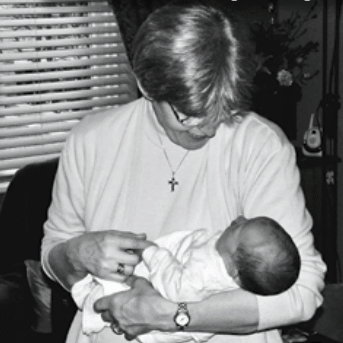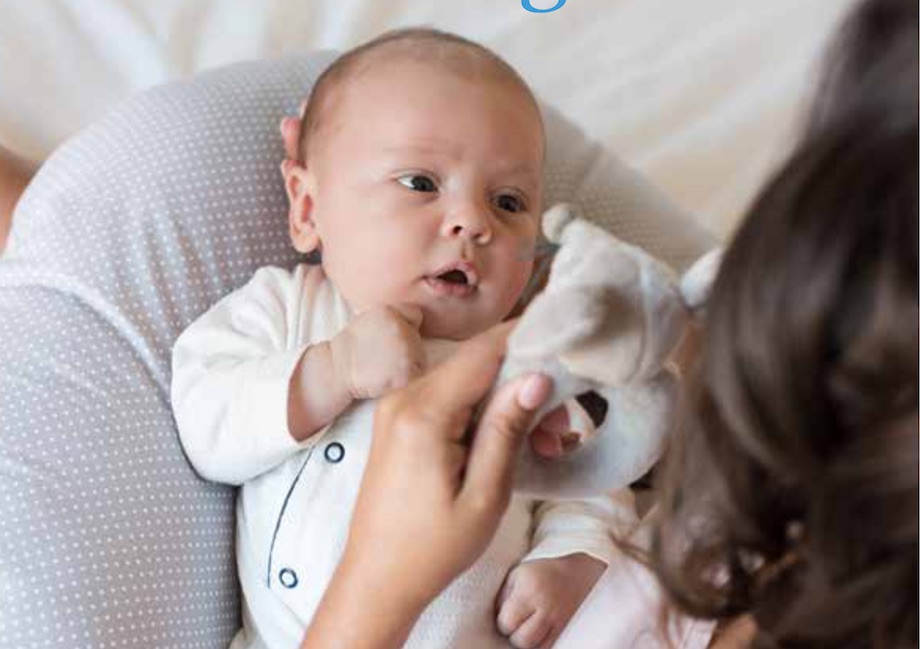
A nipple shield is a shaped, thin, silicone breastfeeding tool that goes over the mother’s nipple and some – or all – of the areola, creating a barrier between the breast and the baby’s mouth. The aim is to help breastfeeding continue in situations that either make it difficult for the baby to latch/feed or cause pain and discomfort for the mother.
Sometimes women experience sore or cracked nipples during their breastfeeding journey. This is primarily caused through a latching issue. When a baby is well-latched on, there shouldn’t be any pressure or trauma to the nipple at all, in fact the nipple should be far enough into the baby’s mouth that mum won’t feel it at all.
Sometimes however, baby’s slip down the breast when tired, or mum hasn’t quite got enough of the areola in baby’s mouth, or if there is an issue such as tongue tie for example, this can put pressure on the nipple resulting in a cracked or sore nipple. Getting professional help for this immediately and learning to correct the latch is critical in solving this problem and for long term success.
According to The Breastfeeding Atlas by Barbara Wilson-Clay and Kay Hoover, written descriptions of nipple shields appeared more than 500 years ago – so they are not necessarily a modern invention. Some studies suggest that nipple shields don’t alter infant sucking patterns (Woolridge 1980), but the fit of a shield in both height and diameter is important to the success of its use – both need to be taken into account to get a good fit for the baby’s anatomy as well as the mother’s breast and nipple shape.
A study of preterm infants showed that milk transfer with a nipple shield was significantly higher than milk transfer without. Using a nipple shield can help a baby transition from bottle to breastfeeding and can ’buy time‘ for a mother who is ready to wean due to breastfeeding problems. Another small study in 2009 showed that 67% of the women said that using shields allowed them to continue breastfeeding, and there was no statistical difference in weight gain over two months.
However, according to Dr Jack Newman’s Guide to Breastfeeding, nipple shields create more problems than they fix and decrease milk supply – he believes mothers would be better to give expressed milk in a bottle. Either way, a nipple shield should not be the first intervention used for problems with breastfeeding, but rather a tool for consideration after other suggestions have been tried. Nipple shields have been shown to be useful in situations such as flat or inverted nipples, disorganised suck and sore nipples.
Which one should I choose?
There are a few nipple shield brands and shapes available. Often the selection comes down to what works and is easily available in local stores. Most are very similar in design. Some have a circular silicon ’base‘ that sits over the areola, while others have a cut-out section on one or more sides.

Above are four common styles of nipple shield from three different brands. Each brand has its own range of sizes; some are available in small (15mm) or standard (21mm), others in medium (20mm) and large (24mm), or simply 16mm, 20mm or 24mm. The size is the measurement at the base of the nipple shape, where it joins the base. However, from the pictures above it is fairly easy to see that nipple shape and size vary from brand to brand as well.
It’s important to pick a shape that will fit your nipple AND your baby’s mouth as well as possible. Your nipple should not feel squeezed across the width or be rubbing against the end of the shield.
What to avoid
The aim of a nipple shield is to provide some protection to the mother’s nipple from trauma caused by the way the baby is feeding, or to assist a baby to latch better than they can naturally, while a solution is found to the cause of the trauma.
The shield is there to provide assistance and protect breastfeeding; however, some nipple shields are designed specifically to keep the baby’s mouth as far away from the nipple and breast as possible. These types of shield do not support breastfeeding at all and can lead to the rapid end of breastfeeding. To remove milk efficiently, the baby must take the nipple and a good mouthful of breast tissue in their mouth. A nipple shield that prevents the baby doing this should not be used.
Nipple shields that look similar to those in the pictures above are usually supportive of breastfeeding; however, if the shield looks different from these, or similar to a bottle teat on top of a base, seek further advice from your lactation consultant or breastfeeding support specialist before using it.
How should I apply the shield?
It may take a bit of trial and error to see what works best for you and your baby. It can be frustrating to get a shield applied and then have it fall off as soon as your baby gets close! Some people find applying a little breastmilk to the underside of the base of the shield can help it stick a little; others prefer warm water. Two ways that seem to generally work well are shown in the video here.
The first is simply to turn the base area of the shield upside down so the shield looks a little like a sombrero. Hold the tip of the nipple part, centrally position the nipple part over your nipple, pushing the shield down quite firmly over and around the edges of your nipple, then with the other hand smooth down the base area over the areola/breast.
The other way is similar, but the nipple shield is turned partway inside out, with the base area being turned further up the sides of the nipple-shaped part. Apply the shield centrally over your nipple, pushing down quite firmly over and around the edges of your nipple. Use your other hand to smooth down the base of the shield over the areola/breast.
It can sound a little tricky, but once you’ve done it a few times, it will become easier.
Feeding with the shield
The same ’rules‘ apply when feeding with a shield as they do without. Your baby needs to be close to you, your baby’s tummy facing your tummy, starting with your nipple just above the baby’s top lip, waiting for a wide gape, and then bringing your baby tight into your breast to latch with their chin touching your breast first: tummy to mummy, nearly nose to nipple, chin first. If you are having trouble latching your baby or your nipple shield prevents your baby having a deep latch and being close to your breast, speak to your midwife, Well Child nurse, lactation consultant, La Leche League leader or other breastfeeding support specialist.
Cleaning and storage
Most shields come with a small storage container, but if not, any small container will do fine. When you have finished feeding, if it’s not comfortable to leave the shield in place for a few minutes, it can be a good idea to put the shield in the container just in case your baby decides they would like a little top-up before they finish.
For the first three months of a baby’s life, it is very important that nipples shields are sterilised prior to use, after this age, wash with warm soapy water and rinse well, then air dry. When you are out and about, it should be fine to wash the shield in warm soapy water, rinse well and store in its container for use again until you are home and able to re-wash and air dry.
You don’t need to have several packs of shields for days out. When you sterilise nipple shields, avoid sterilising tablets or similar as silicon absorbs the chemicals.
Is it working?
The easiest way to know your baby is getting enough milk is by weight gain and nappy output! If your baby is gaining good weight, they are getting enough milk. If your baby is having lots of wet and dirty nappies, they must be getting milk too. If your baby’s weight gain has been a concern prior to using nipple shields, it might be worth arranging with your midwife or Well Child nurse to weigh your baby in a couple of days to see how things are going.
If you have been concerned about milk supply, remember the more you feed your baby, the more milk you will produce, so look to feeding your baby more regularly for a few days, to boost your milk supply. Check in with your local Le Leche League, Lactation Consultant, or other professional to get further help and information on this.
When your baby is feeding well with the shield, you should see evidence of milk in the shield, your breasts should feel softer and emptier after feeding, and your baby should finish the feed looking relaxed and satisfied; often their hands will be soft and relaxed by that point.
What next?
If your baby is feeding well with the shield – good weight gain and milk supply not compromised in any way – there is no need to rush to stop using it. The most important thing is that your baby has a good deep latch when feeding and doesn’t use the shield like a straw or teat, with a shallow latch; this can lead to low weight gain and a reduction in milk supply. The shield will not fix whatever the problem was in the first place; it is simply a tool to help maintain breastfeeding while the source of the problem is resolved.
If your baby had a shallow latch that caused damage to your breasts leading to the use of the shield, the shallow latch still needs to be resolved. Removing the shield without solving the issue will lead to the same problems returning.
Once you are confident that feeding is going well and issues have been resolved, you can start to see if your baby is happy to feed without the shield. Some babies are happy to do so, others take more time, and some will happily continue with the shield for their entire time of breastfeeding – even if that is months or years. Some tips to try when weaning from a nipple shield are:
- Have lots of skin-to-skin contact when feeding your baby, allowing them to use their natural instincts to find the breast.
- Remove the shield partway through the feed.
- Feed your baby as soon as they wake.
- Feed at the earliest feeding cues while they are still calm.
- Try feeding in a different position, or even standing up and walking around.
- Express a few drops of breastmilk so your baby can taste milk immediately.
If an attempt to feed without a nipple shield is not successful, try not to feel stressed or anxious; stay calm and continue the feed with the shield. Attempts to persist and force your baby to feed without the shield will make feeding stressful and unsuccessful for both of you.







